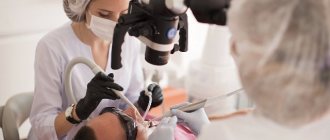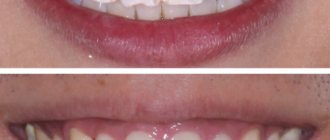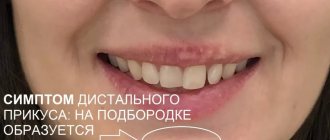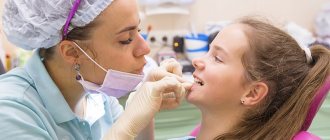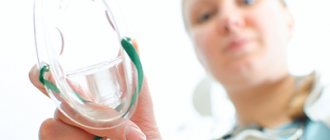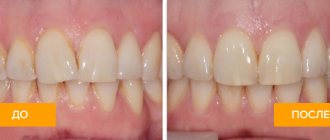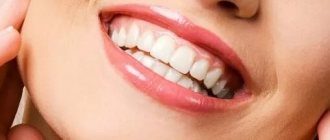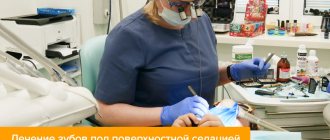If you are reading this article, it means that you are interested in improving your bite and are considering braces.
This shows that you have the determination to achieve a healthy, charming smile.
Here we have collected the questions that people most often write to us in messages.
I hope this changes your life for the better, just like it has changed the lives of thousands of other people.
Can adults get braces to correct their bite?
Anyone can correct a malocclusion, regardless of age. But in an adult, this process takes longer than in children, because skeletal growth has already stopped and hard bones are more difficult to form.
In addition, some oral health conditions may delay the installation of braces. For example, caries, periodontal disease, endocrine diseases.
Sometimes the effect of treatment is influenced by the presence of crowns and bridges. The treatment period starts from 1.5 years.
Slight crowding of lower incisors and canines
A prerequisite for installing braces only on the lower jaw is acceptable closure of the lateral sections of both jaws. But the doctor must determine in advance how much free space will be needed to straighten the lower crowded teeth with a brace system. And that's why.
The required space can be obtained in different ways. Expanding the row is unacceptable, since in this case it will lead to pathology - a violation of the closure of the jaws. What remains is the method of repairing dental crowns. Their contact surfaces are slightly ground - literally by 0.25 mm, which allows you to release 2-3 mm without harm to the teeth.
Thus, if there is a shortage of space up to 3 mm, it is possible to get by only with braces on the lower teeth. Otherwise, treatment will take place on two jaws.
Does teeth straightening hurt?
The installation of braces itself is painless, but requires patience because it takes about an hour.
For 7-10 days, teeth may hurt when biting. The body must get used to foreign objects. In general, you live your old life, you just notice pleasant changes in yourself.
Control visits are needed to correct the process and form the correct position of the teeth. Usually after changing the arch the pain goes away within 3-7 days. It all depends on individual sensitivity.
For some, wearing braces is only unpleasant, for others, on the contrary, it is painful, and some do not feel anything.
Fixed retainers
A permanent retainer is a wire arch made of medical steel, which is attached to the inside of the teeth with a special compound. This type of retainer is used most often, as they are completely invisible, cannot be felt in the mouth and do not oxidize. Fixed retainers can come off due to mechanical stress, such as chewing hard food. In this case, you should immediately visit the orthodontist and return the retainer to its place to prevent the teeth from moving.
Fixed retainers have many advantages: you can’t forget to put them on - they are always on your teeth, and they are absolutely invisible and do not interfere. The main feature of wearing a fixed structure is the need for careful home hygiene and professional cleaning every six months at the dentist, since plaque in hard-to-reach places around the retainer is more difficult to clean.
Do braces make it difficult to eat?
Once installed, you will need to learn how to eat in them. This period takes on average 3-7 days.
At this time, give preference to soft and liquid foods. Cut fruits and vegetables into small pieces. Avoid fibrous and sticky foods.
Over time, you will be able to eat almost everything except Coca-Cola (can dissolve glue), hard foods (nuts, crackers, chocolate) and sticky sweets (chocolate, cookies or caramel bars). You should also not chew gum.
What problems can arise with a retainer?
The first thing a person who has a permanent retainer installed will face is getting used to it. At first, the retainer may rub your tongue, feel too big in your mouth, and interfere with clear diction. The retainer becomes invisible in the mouth after about a week.
The next task for a patient with a retainer is careful home hygiene, since food debris can get stuck in the spaces between the teeth and the retainer. For home cleaning, we recommend using a single-tuft brush, brushes, dental floss and irrigator.
The retainer may break or come off due to hard foods. In this case, you need to contact your doctor for a replacement.
If caries appears in the area of the retainers on the teeth, then for treatment by a therapist, the retainer will need to be removed and then reinstalled.
How often should inspections be carried out?
Every 1-2 months, it all depends on the defect and the individual structure of the patient’s teeth. During the visit, the orthodontist checks the success of the treatment and sets a vector for the arch, which determines the movement of teeth in the right direction.
Missing follow-up visits may negate the effect of previous treatment. You are also required to visit a hygienist every six months.
Braces, whether external or internal, need to be worn for an average of 1.5 years. But determining more precise timing depends on the initial situation and age of the patient. Sometimes it takes 2 years to eliminate a defect.
What parents need to pay attention to
Ages 3 to 6 years
It is necessary to pay attention to early signs that contribute to the occurrence of improper development of teeth and dentition.
Let us list the points that help a child’s teeth grow crooked:
- early loss of baby teeth,
- breathing disorders,
- closing of the child's lips during sleep,
- sluggish, slow chewing and swallowing,
- speech disorders,
- poor posture,
- bad habits - sucking fingers, tongue, objects.
When studying the survey data, it was revealed that the majority of patients (95%
) were referred to an orthodontist after 6 years.
I don’t doubt for a second that if you knew that your child could develop a malocclusion, you would immediately begin to follow the doctor’s advice: change your diet, eliminate bad habits, and perform therapeutic exercises. This relates to the question of how early you should see an orthodontist.
Why do something now, when it’s already clear that “the teeth are crooked, when they grow, then we’ll put braces on him”
In the modern world, orthodontics plays a huge role. The desire for a beautiful, even smile, the desire to have snow-white, straight teeth becomes the norm of life. Thus, it is obvious that by referring children in early childhood to an orthodontist, who can give professional advice on the prevention of dental anomalies, it is possible to prevent the formation of malocclusion in children. And avoid dental problems in adulthood.
My doctoral daily practice in communicating with children and parents shows a fairly good awareness of orthodontic treatment methods. About the existence of dental plates and braces
, we don’t have to talk about trainers for a long time - these types of orthodontic structures are the most common, widely known to both the small and adult population.
Early treatment takes advantage of progressive, irreversible tissue changes during tooth growth and eruption, targeting them to stop the development of the anomaly before significant dental and morphological compensation occurs.
The main task facing the orthodontist is the following: it is necessary to give the teeth the correct vector of development
, create conditions around the teeth for their optimal growth!
Dear friends, in early childhood, the orthodontist, together with the parents, is the coordinator of the correction of dental anomalies that form during the period of active growth of the child’s teeth. The consequences of inaction - that is, waiting until the child grows up and you install permanent braces or any other aggressive devices - are more difficult to treat and retain, and maintain the achieved result.
By using early orthodontic treatment, you and I have the unique ability to manage tooth eruption to minimize the need for future tooth movement.
Why are records needed?
Most practicing orthodontists find it difficult to determine exactly when it is worth interfering with the formation of malocclusion, and when Nature should still “do its thing.” This is because experience only comes after years of careful observation, and the decision to intervene is often driven by parental demands to “do something.”
Orthodontic care for a child consists of the use of preventive and therapeutic measures - myogymnastics, hardware and surgical treatment. The most common of them is the hardware method.
A dental plate is a passive removable orthodontic device, and if a screw or various spring elements are added, the design becomes an orthodontic device with active mechanical action. The activity and strength of the device depends on how many millimeters the doctor has extended and activated the spring, tightened the screw, etc. The fulcrum in them is the teeth and the alveolar process under the base, the regulating active part is a screw, a spring, and the clasp is a fixing part.
How to sleep with dental plaques, will my child swallow them at night while sleeping?
There is no reason to panic, dear friends, the orthodontic device (plate) in the correct individual high-quality production is sufficiently tightly fixed due to the hooking metal elements, as well as the anatomical shape.
When putting on the dental plate, you can hear a characteristic click - this is a positive thing. It is very important to properly remove and put the plates on your child’s teeth so as not to bend their wire elements, and also carefully monitor their cleanliness and maintain hygiene.
What to do if the bracket comes off?
In itself, this happens quite rarely, only in cases of severe crowding of teeth, since the arch puts a lot of pressure on the dentition and the lock falls off. Another option is if the patient is a nut or other solid food lover.
If you find a broken bracket, contact your orthodontist immediately. Otherwise, the teeth will begin to gradually move to their original position. Also remove elastic bands if you wear them.
The doctor sees patients with unstuck braces out of turn. It takes about 5 minutes to glue a new lock.
It also happens that the archwire flies out of the bracket grooves. You can try to get it back yourself. However, this should be done extremely carefully, without damaging the adjacent locks.
Removable braces: pros and cons
Mouthguards, plates, trainers have a list of undeniable advantages. They also have some disadvantages. Let's list both.
Pros of removable devices:
- The tight fit to the teeth and transparent material ensure that the product is invisible to others.
- The patient quickly gets used to the device and does not feel discomfort or pain during the treatment process. The correction occurs gradually, in a gentle manner.
- Hygienic procedures are easy to carry out , since the patient can independently remove the structure from the mouth without any problems.
- It is possible to correct a schoolchild’s bite when the dentofacial apparatus is still developing.
- A person wears a removable system for only 11-15 hours/day, which allows him to go out into public places without it.
- With the help of such devices, you can wean your child off bad habits that can negatively affect the bite.
- The products are suitable for children who refuse to wear traditional permanent braces.
- Aligners, orthodontic caps and trainers help to fix the result obtained during treatment with conventional braces. They prevent teeth from returning to their original incorrect position.
One of the disadvantages is the inability to treat serious deviations in the structure of the dentofacial apparatus. In addition, these devices are not always suitable for adults. They are most often used for children.
How to brush your teeth with braces?
This is where a traditional toothbrush and toothpaste don't serve their purpose. Therefore, you will need to buy a special orthodontic brush, brushes and floss from the pharmacy. You can also use an oral irrigator if you wish.
This way you can effectively clean your teeth and the area around the locks. Teeth should be thoroughly brushed after each meal, because food debris is deposited on braces, which contributes to the development of caries and does not look aesthetically pleasing. We have repeatedly encountered patients whose teeth are more well-groomed than those of a person without braces.
Night braces
Braces are non-removable structures that are used to correct bite pathologies for 1–2 years. Such systems are installed by the attending orthodontist and during treatment, only he can remove them. Removable systems in orthodontics have names: aligners (aligners), plates and orthodontic trainers (later we will analyze each type separately). Such systems differ from braces in that they do not require continuous wearing. The design can be put on and taken off independently when circumstances require it.
Night guards or plates can correct problems with malocclusion only in the early stages of its development, therefore they are most often prescribed to children under 12 years of age. When the dentition is fully formed, such structures will not be able to correct the incorrect position of the teeth and make a serious bite correction.
Mouthguards are worn at night and for several hours during the day. So that the child does not feel discomfort and overcomes the psychological barrier more easily, manufacturers offer designs of various colors and shapes. These can be completely transparent or covered with glitter systems in the form of elephants or hearts.
Orthodontic night structures are divided into single-jaw or double-jaw. More details:
- Single-jaw – worn only on the upper or lower dentition. They have lost their popularity due to their low effectiveness in correcting malocclusion.
- Double-jawed - put on both jaws. They promote the proper development of a child’s jaw, and are also used to wean a child from bad habits (for example, biting nails or grinding teeth). Helps in the formation of the correct bite.
In some cases, night systems are also used for adults. Minor defects in the bite, small tooth rotation, small interdental space, or to consolidate a positive result after bite correction with braces.
The main question for all patients. Can night braces affect your sleep?
The orthodontic structure is made in such a way as not to interfere with the functioning of the respiratory organs and not cause pain.
Are braces the last stage of orthodontic treatment?
After removing braces, you need to consolidate the effect of straightening your teeth. For this purpose, retainers are made that will protect teeth from returning to their original place.
There are two types of retainers:
- Removable – transparent, plastic mouth guards. Used only at night or during a certain period.
- Non-removable - made of metal. They are installed on the back surface of the teeth using special composite materials.
The decision on the best method is made by the orthodontist. The aligners must be worn at all times during the first month, removed only for eating and brushing your teeth. On average they are worn for 2 years.
While wearing retention devices, you must visit a doctor every 3-6 months.
Types of removable bracket systems
As noted earlier, removable night structures are divided into several types. More details about each of them:
- Mouthguards (caps or caps) – made of polymers or non-oxidizing metal using 3D computer modeling technologies, used in orthodontic treatment. Mouthguards are made individually for each patient, depending on the existing bite problems. First, an impression is made of the dentition and with its help a whole set of aligners is created. Each product differs from the previous one with a slight difference in order to gradually move the tooth into the correct position. One mouthguard is used for 14–20 days, after which it is changed to the next unit.
- The plates are removable structures that can only be used at night. In orthodontics, they are often used to treat various pathologies in the development of the jaw in children. They promote the correct construction of the dentition, the correct formation of the carpal tissue of the jaw, and are also used for forced expansion of the palate. The plates are made individually according to the cast model. They are held on the teeth using thin wire hooks. They can be easily removed for eating or brushing teeth, after which they can be put on independently. When the plate is intended to straighten teeth, special springs, arms and hinges are mounted into its frame. If the plate is used to expand the jaw of a child, an expansion screw is inserted, which is located between the halves of the structure. For children they are made in different colors.
- Orthodontic trainers are made using elastic silicone, which makes them comfortable to use. They have a universal size and do not require correction while wearing. Trainers are installed overnight. Easily fits in the child's mouth. Despite the fact that swallowing the trainer is excluded, the baby should still be under the supervision of an adult. It is used to eliminate excess pressure from the tongue, cheeks and labial muscles on the rows of teeth, separating them from each other and normalizing the correct position. Thus, breathing, swallowing functions, the position of the tongue are normalized, and the dentition is placed in the correct relationship. The result of the impact of orthodontic trainers is that the child’s bite is corrected, all functions of the jaw muscles are normalized, the teeth take the correct position, the correct growth of the jaw is stimulated, which is why facial features are improved.
All three types of removable braces will help the child get rid of such bad habits as licking the gums with the tongue or putting it in between the teeth, finger sucking and mouth breathing. The child’s teeth are straightened even during the period when the bite changes and this allows one to avoid orthodontic treatment in the future, which means eliminating the possible removal of healthy molars.
Can you continue to live with crooked teeth?
Crooked teeth are more vulnerable to tooth decay and periodontal disease. If teeth grow incorrectly, their surfaces become excessively worn down when eating, which worsens the malocclusion. Therefore, sometimes it leads to serious diseases of the temporomandibular joints.
In addition, if you suffer from frequent headaches, chondrosis, or have tinnitus, it is better to check your bite.
The process of installing permanent retainers
Retainers are installed after braces are removed on completely healthy teeth after professional hygiene. The patient may need to undergo oral sanitation after orthodontic treatment. While wearing braces, it is difficult to clean your teeth perfectly, and accumulated plaque can cause caries and tartar. Retainers cannot be installed on affected teeth, since another design in the mouth will again complicate hygiene and lead to a deterioration in the condition of the oral cavity. Also, during orthodontic treatment, the enamel may become thinner, so in addition to hygienic cleaning, teeth need fluoridation and mineralization.
After carrying out therapeutic and preventive measures, the orthodontist begins the laboratory stage of manufacturing retainers. An impression is taken from healthy teeth, according to which the retainer is given the necessary shape of the dentition.
Before the actual installation of the retainer, the teeth are etched with a special solution so that their surface becomes slightly rougher for better adhesion. In some cases, instead of etching the teeth, the teeth are prepared: a microgroove is drilled on the inside to fix the retainer. Once the teeth are prepared, the retainer is placed in the desired position and secured with composite material. The procedure is completed by grinding the material for the patient’s convenience.
The installation procedure takes 15-20 minutes and is absolutely painless. But in the first days of adaptation, the retainer can rub and reduce the clarity of diction.
Braces hurt the oral cavity, what should I do?
After installing braces, each patient receives wax for locks from the orthodontist. At the very beginning, it is worth applying it to the entire system, because the mucous membrane in the oral cavity is not yet accustomed to contact with foreign objects.
Abrasions and wounds heal very quickly. Their healing can be accelerated by using agents that promote the healing of wounds in the oral cavity.
Is it possible to get braces instead of implants?
Moving adjacent teeth into the socket of the removed one is a common alternative to implantation. In terms of timing and price, these procedures differ little. Not all orthodontists undertake such treatment; experience and skills are required. In our Center, orthodontic treatment is used to replace a lost tooth, but the choice of method depends on:
- number of missing units - the distance to which adjacent teeth will need to be moved is estimated;
- location of the defect - frontal or chewing zone;
- the age and health of the patient - the possibility of performing an implantation operation and the effectiveness of orthodontic treatment are assessed;
- quality and quantity of bone tissue in the area of missing teeth - if there is not enough bone, bone augmentation is carried out during implantation; installation of braces is not always possible in such a situation.
Braces allow you to avoid implantation if one of the distant dental units (molar or premolar) is missing. The teeth adjacent to the missing one move and close the gap. But the method is not suitable if the frontal unit is removed, since the front teeth differ in shape. In this case, implantation will be required, which can be combined with the installation of braces to correct the dentition.
If the patient already has braces installed and a tooth needs to be removed, existing structures are used.
Related articles:
- Center guarantees
- Our advantages
- Press about us

